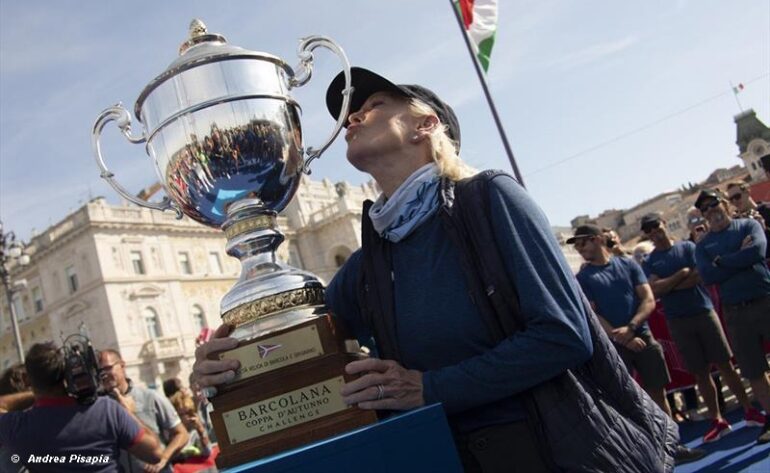In the vast expanse of the open sea, where the wind whispers through the sails and waves dance in rhythmic harmony, a new era is unfurling its sails. Women in sailing are not just navigating the waters; they are rewriting the narrative, leaving an indelible mark on the maritime horizon.
The recent triumph of Wendy Schmidt, the trailblazing skipper-owner of the American team Deep Blue, in the Barcolana54, the world’s largest sailing race, epitomizes the spirit of women breaking barriers on the high seas. Wendy’s victory not only secured her place in history as the first woman to helm her way to the pinnacle of the Barcolana but also illuminated the path for future generations of women sailors.
As the Barcolana Trophy sailed across the Atlantic to the storied New York Yacht Club, it carried with it not just the weight of metal but the resilience, determination, and grace exemplified by women in sailing. The traditionally male-dominated realm of sailing is undergoing a transformative shift, as more women take the helm, both figuratively and literally.
Wendy Schmidt’s dual triumph, clinching both the Barcolana Trophy and the Trofeo Generali Women in Sailing, underscores the versatility and capability of women in maritime pursuits. The Trofeo Generali, awarded to the first female leader of a mixed crew, stands as a testament to the collaborative spirit that defines sailing and showcases the strength that emerges when men and women navigate the challenges together.
Beyond the accolades and trophies, Wendy Schmidt’s victory is a beacon illuminating the vast potential within every woman who sets her sights on the horizon. It sends a powerful message that the sea is not bound by gender; it is a canvas waiting to be painted by the skill, courage, and determination of any sailor, regardless of gender.
The story of women in sailing is not confined to a single victory. It resonates in every gust of wind that fills the sails of a woman-led crew, in every navigation chart meticulously plotted by a female navigator, and in every triumph that defies the outdated stereotypes that have lingered in maritime history.
As we celebrate the accomplishments of Wendy Schmidt and countless other women who have embraced the call of the sea, let us also recognize that this is just the beginning. The sails of change are billowing, and the horizon is vast and open for more women to explore, conquer, and inspire. The oceans, once seen as a symbol of challenge, are transforming into a canvas for women to paint their stories of courage, resilience, and uncharted victories. The winds of change are blowing strong, and the women in sailing are at the helm, guiding us into a future where the sea knows no gender, only the boundless spirit of adventure.
Navigating New Horizons: Women Redefining Sailing Leadership
In the realm of competitive sailing, once considered an exclusive old-boys’ club, a wind of change is propelling women not only onto the deck but into the captain’s chair. Over recent decades, women have not only joined the sailing community but have also assumed key leadership roles, steering boats and organizations with finesse and determination.
Breaking barriers, the victory of a female skipper in the 2018 around-the-world race marked a historic moment in sports. Moreover, five all-women’s teams have conquered the arduous round-the-world Volvo Ocean Race, now rebranded as the Ocean Race. The last American Olympic gold medal in sailing was clinched by a woman in 2008, and women have even triumphed in the esteemed America’s Cup, exemplified by Dawn Riley’s historic achievement in 1992.
Dawn Riley, now a leading figure in high-performance sailing training centers in the United States, reflects on the journey. Yet, she acknowledges the unique challenges she faced, having discovered a male crew member with similar duties and experience earning twice her salary.
Pamela Healy, a bronze medalist at the 1992 Summer Olympics, emphasizes the vital role of female leaders, citing a Harvard Business Review study that highlights the success of corporations with diverse boardroom dynamics. While progress is evident, Healy notes room for improvement, advocating for increased representation in yacht-club leadership and enhanced opportunities for boat ownership to achieve true equality.
Despite challenges, these women trailblazers are catalysts for change. Cory Sertl, president of US Sailing and vice president of World Sailing, underscores the evolving landscape of sailing, with initiatives for gender equity gaining momentum. Sertl’s motion for gender equity in classes of boats and Olympic events five years ago reflects a commitment to transforming the sport.
Sam Davies, an accomplished offshore sailor, offers a unique perspective, acknowledging that challenges in sailing arise more from the difficulty of the sport than gender-specific obstacles. Davies believes that sponsorships may be more accessible for skilled women, given the sport’s male-dominated nature.
However, Wendy Tuck, the sole female skipper to have won an around-the-world race, sheds light on the challenges of securing sponsors and suitable boats for female skippers. The underrepresentation of women at the helm persists, impacting confidence, as noted by Kristina Plattner, skipper of the TP52 Phoenix 12, who emphasizes the importance of role models.
As women continue to redefine sailing’s narrative, the push for gender equality in leadership, sponsorship opportunities, and boat ownership becomes paramount. The winds of change are not just steering sails; they are ushering in a new era of inclusivity, where women are not merely taking a seat but navigating the course of sailing’s future.
